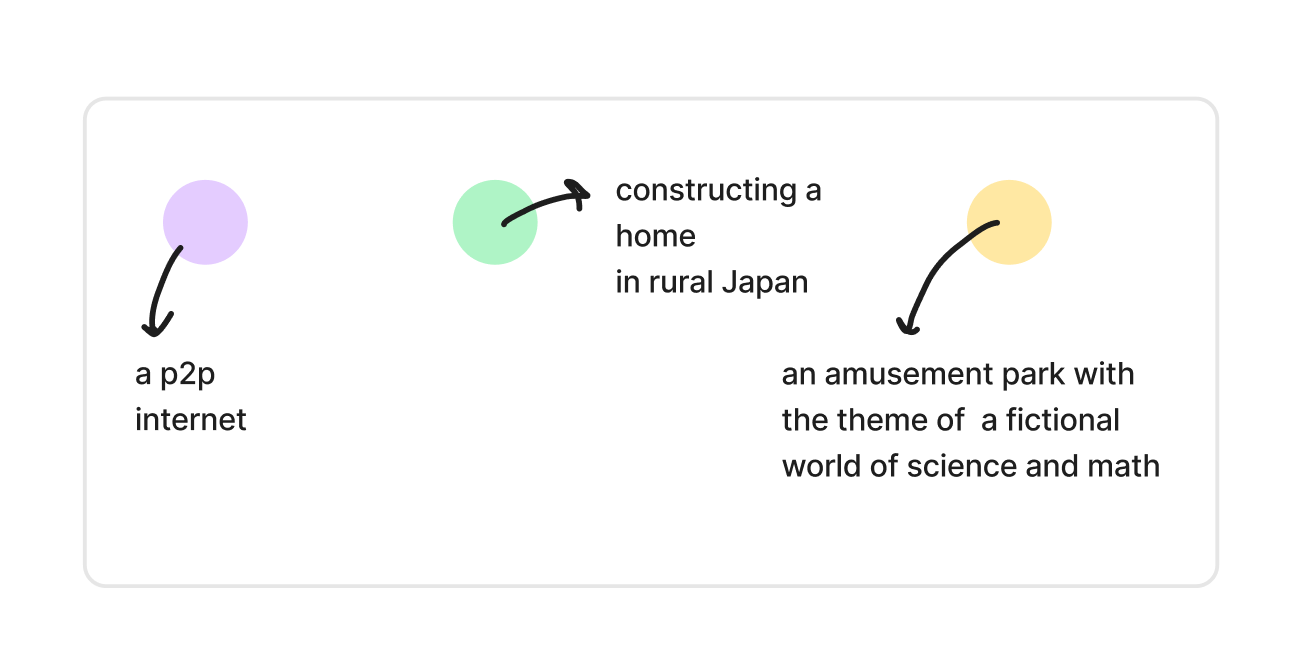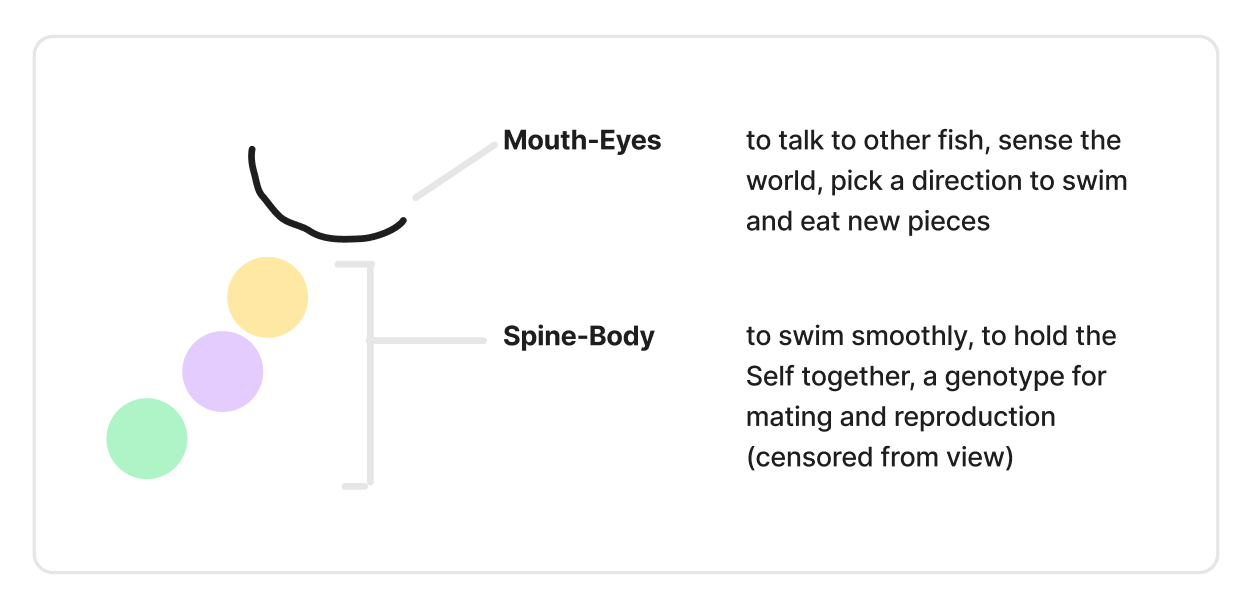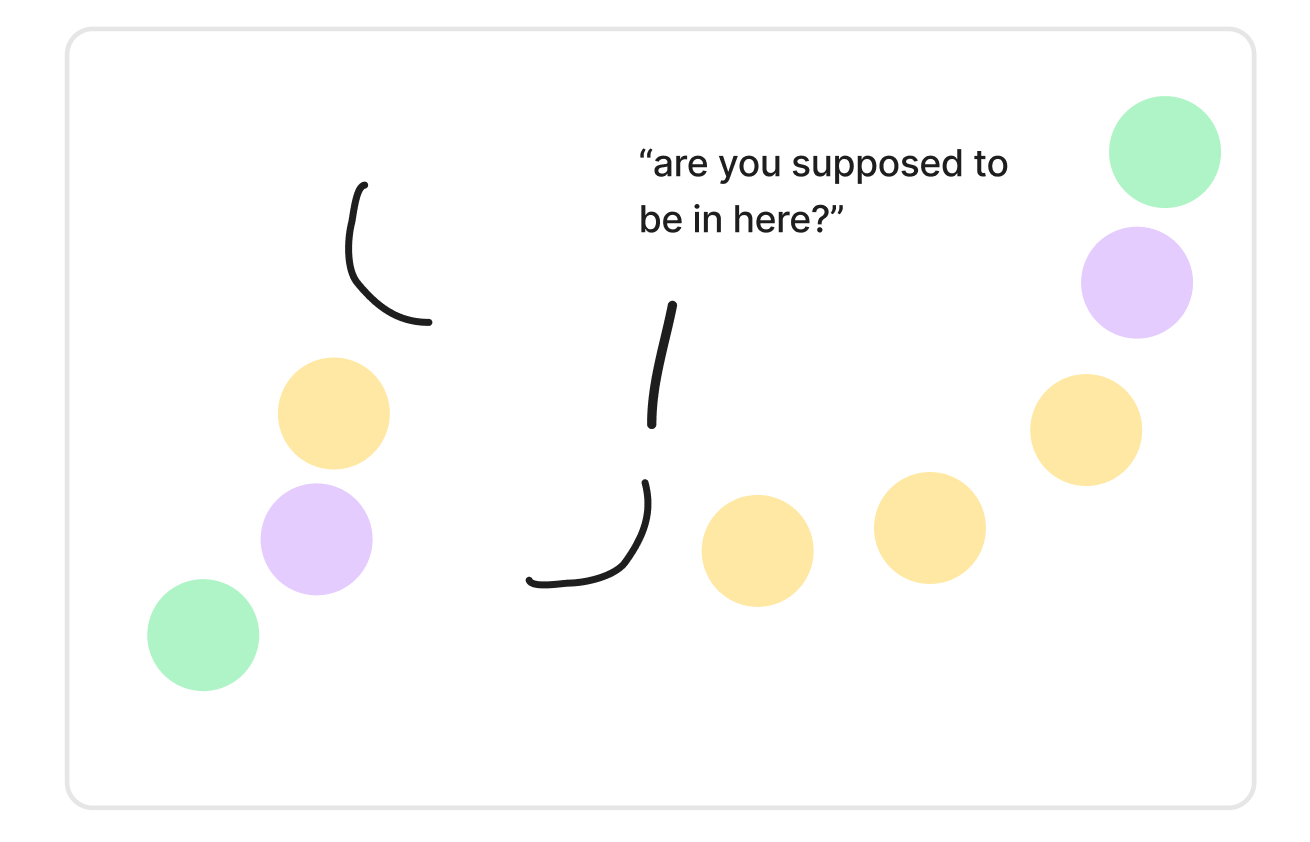fish.sim
Reflection 1 of 2: Narratives of Self, as told by complexity science, psychology and game design.
Investigated in March 2024, revealed in July 2024.
fish.sim is a character builder and simulation engine for experimenting with possible Selves.
You are not the company that you keep. You are not what you eat. You are not your job. Instead, your “Self” is an assembly of pieces of Knowledge, Experiences and Dreams. Each piece can be very small or very large, or something somewhere in the middle:
Knowledge can range from concepts like malleable interfaces to equine otolaryngology to entire tracts of knowledge like all of Chemistry.
Experiences can range from moments of watching komorebi from the window to life events like quitting your first job to entire tracts of a life like your first relationship, existing to teach you how to love in life than to close love’s case for life.
Dreams can range from realizing near-term tasks like replying to Suzanne’s email, to intentions like understanding the system of scientific publishing to visions like a concrete design studio affixed with glass and draped with flowering vines. Dreams are possessions of a Future Self gifted to him by the Present Self, the one with Knowledge and Experiences.
Think of these pieces as the “shards of one’s self” from Harry Potter, except that you don’t need to murder someone to get it. Instead, you can find it or borrow it, as we’ll see soon.
The Character Builder
The Character Builder is a map location in fish.sim that lets you construct possible Selves. This begins by drawing up pieces of Knowledge, Experiences and Dreams from the Well of All Human Experience using a bucket-shaped device called the Wayfinder, as it is often through new Knowledge, new Experiences and new Dreams that one finds one’s way.
Once drawn up from the well, Wayfinder lets you play with these pieces; zoom in and out of a piece, explore its neighbors, dive into its children. If you like the pieces you discover, you can collect them into your Inventory.
Today, I drew up three pieces that I didn’t know were possible, but once I saw them, they simply made sense to me:

Picking from your Inventory, you can use Wayfinder to join these pieces into characters. You can either carefully construct characters piece by piece, remix your friends’, or use my favourite technique - the Mardi Gras Tool. The Mardi Gras Tool takes whatever is in front of you and mixes it up in every which way possible over one grand night of colorful celebration.
With my three pieces from earlier, there are 6 possible ways to combine them into possible Selves:

Once we have the arrangements, we cast a spell and turn them into living, digital creatures called Fish. Every Fish has Mouth-Eyes and Spine-Body,
The Simulation Engine
Each Fish is often unique, for combinatoric reasons. But what makes any Fish special is not its unique constellation of pieces, no, but how this Fish interacts with other Fish - you mean to me because of what you share with me.
We can’t predict what must emerge, and so Fish interact through Scenes: environments and plot points that stir a connection between unlikely casts of characters (Fish).
Scene 1. INT: the floor of a cinema before a showing of Shrek.
Narrator: @p2p-ruralHome-amusementPark Fish spills @p2p Fish’s water, a stranger and fan of the franchise seated next to them. What happens next?
Sometimes, my fish can also go on journeys and meet your Fish.
Scene 2. INT: a biosciences lab in Oxford.
Narrator: @p2p-ruralHome-amusementPark is trying to get super glue off their hands. They sneak into the lab at midnight with a key card they found on the floor. They find rubbing alcohol to get it off, but are caught by @longevity-niceBaguette-romantic Fish as they are taking a break from imaging an intestinal organelle. What happens next?
What happens when we run all of these, all at once? What will we learn about every possible combination of ourselves, interacting with every possible combination of ourselves and of others? Past Selves interacting with our Future Selves. My present Self interacting with your Future Self. What happens if they each are allowed to only exist exactly once?
Afterword
In early July and under the guise of a “tool-for-thought”, we demoed fish.sim to a panel of VCs. At the end of the 30-minute call, they would decide whether or not to disburse half a million dollars to fund fish swimming around a whiteboard, at scale.
During the demo, we made two Fish. In the interest of an MVP, they were assembled not from combinations of Knowledge, Dreams and Experiences, but just a subset of Knowledge we termed “Concepts”.
Concepts were extracted from Media that you pulled from sites on the internet, such as the copy on the curl.projects website. You could also play with these Concepts by joining them together to form new Concepts (a glimpse at Wayfinder).
During a test, we birthed one fish containing the Concepts of “Spaces for Contemplation” (from curlprojects.com) and “AI Interfaces”, and another Fish containing ... nothing. Call it Just a Fish.
When asked “what is contemplation?”, it replied, in fish-like fashion,
“contemplation feels like finding the calm spots in the water, where the currents slow down and I can swim in stillness, sensing myself and the others around me”.
It was Just A Fish’s turn.
We ask it, “What is Contemplation?”, and it replies,
“I’m a fish, glub glub”,
in character for a fish that knows nothing.
Finn (see: nominative determinism) and I respond with a laugh, and the panel of VCs turns to us and asks,
“and what problem is this solving?”




